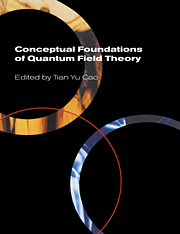Book contents
- Frontmatter
- Contents
- List of contributors
- Preface
- Photographs of the conference
- Introduction: Conceptual issues in quantum field theory
- Part One Philosophers' interest in quantum field theory
- Part Two Three approaches to the foundations of quantum field theory
- Part Three
- Part Four Mathematics, statistics and quantum field theory
- Part Five Quantum field theory and space-time
- Introduction
- 12 Quantum field theory and space-time – formalism and reality
- 13 Quantum field theory of geometry
- 14 ‘Localization’ in quantum field theory: how much of QFT is compatible with what we know about space-time?
- 15 Comments
- Part Six
- Part Seven Renormalization group
- Part Eight Non-Abelian gauge theory
- Part Nine The ontology of particles or fields
- Part Ten
- Name index
- Subject index
12 - Quantum field theory and space-time – formalism and reality
Published online by Cambridge University Press: 22 September 2009
- Frontmatter
- Contents
- List of contributors
- Preface
- Photographs of the conference
- Introduction: Conceptual issues in quantum field theory
- Part One Philosophers' interest in quantum field theory
- Part Two Three approaches to the foundations of quantum field theory
- Part Three
- Part Four Mathematics, statistics and quantum field theory
- Part Five Quantum field theory and space-time
- Introduction
- 12 Quantum field theory and space-time – formalism and reality
- 13 Quantum field theory of geometry
- 14 ‘Localization’ in quantum field theory: how much of QFT is compatible with what we know about space-time?
- 15 Comments
- Part Six
- Part Seven Renormalization group
- Part Eight Non-Abelian gauge theory
- Part Nine The ontology of particles or fields
- Part Ten
- Name index
- Subject index
Summary
Although thinkers had been groping for two hundred years for the idea of a field - something that would transmit forces across the vastness of interstellar space - it was not until Faraday and Maxwell that field theory in the modern sense was born. Not really in the modern sense, of course, because it was not initially decided whether fields are merely mathematical descriptions of a deeper reality or are themselves physical entities that occupy the absolute space of Newton. Maxwell certainly regarded the electromagnetic field as something physical, but he was curiously unwilling to ascribe to it an independent existence as a ‘nonmechanical’ entity in its own right.
Even Einstein, in the early years of this century, was unwilling to ascribe an independent existence to the gravitational field. Instead he made the bold advance of expressing it, not as something that occupies space-time, but as a property, curvature, of space-time itself, and he tried to develop a geometrical theory of the electromagnetic field as well.
The question ‘Are fields merely mathematical descriptions of a deeper reality, or are they independent physical entities?’ and questions like it, recur over and over in different guises. As titillating as such questions may be to some philosophers, the modern response to them is surely that they are irrelevant.
- Type
- Chapter
- Information
- Conceptual Foundations of Quantum Field Theory , pp. 176 - 186Publisher: Cambridge University PressPrint publication year: 1999



